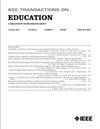Toward Uncovering Meaning in Human-Robot Interactions
IF 2
2区 工程技术
Q2 EDUCATION, SCIENTIFIC DISCIPLINES
引用次数: 0
Abstract
Contribution: This study qualitatively uncovered meaning for why and what was motivating to undergraduates participating in an educational human—robot interaction (HRI) experience. A data corpus of four documents (groups) was evaluated from a quasi-experimental, nonequivalent control (探索人与机器人互动的意义
贡献:本研究从定性角度揭示了大学生参与人机交互(HRI)教育体验的原因和动机。通过对准实验、非等效对照(${n}\\,=$ 23)和治疗(${n}\\,=$ 61)研究设计中的四个文档(组)的数据语料库进行评估,揭示了三个主题,即为什么和什么对学生有激励意义。背景:工程教育文献表明,人力资源指标对学生的学习动机和学业成功有积极影响。然而,目前还没有严谨的研究来说明在这些 HRI 体验中激励学生的原因和意义。预期成果:本研究的结果代表了实质性的发现,回答了在人力资源创新体验中为何和何为激励的问题。然而,未来的研究还需要进一步了解人力资源创新中动机的细微动态和多维方面。应用设计:为了分析学生的定性开放式调查回复,我们使用了结构化词频(tf)、tf-反向文档频率(tf-idf)、潜在德里赫利特分配(LDA)建模和内容分析,因为这些方法在计算文本挖掘中非常典型。研究结果在描述对人力资源创新的动机时,发现学生们形成了一个共同的词汇表来描述动机的原因和内容(例如,"......[能够][看到][机器人]跟随[线]......")。这表明,学生们体验到的具体、直观、即时的反馈是激励他们的原因和动力。
本文章由计算机程序翻译,如有差异,请以英文原文为准。
求助全文
约1分钟内获得全文
求助全文
来源期刊

IEEE Transactions on Education
工程技术-工程:电子与电气
CiteScore
5.80
自引率
7.70%
发文量
90
审稿时长
1 months
期刊介绍:
The IEEE Transactions on Education (ToE) publishes significant and original scholarly contributions to education in electrical and electronics engineering, computer engineering, computer science, and other fields within the scope of interest of IEEE. Contributions must address discovery, integration, and/or application of knowledge in education in these fields. Articles must support contributions and assertions with compelling evidence and provide explicit, transparent descriptions of the processes through which the evidence is collected, analyzed, and interpreted. While characteristics of compelling evidence cannot be described to address every conceivable situation, generally assessment of the work being reported must go beyond student self-report and attitudinal data.
 求助内容:
求助内容: 应助结果提醒方式:
应助结果提醒方式:


